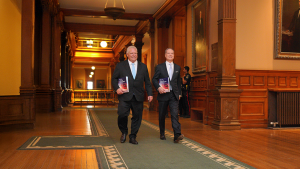Municipalities across Alberta are not receiving enough provincial funding to tackle a $30 billion infrastructure deficit.
In an interview with the Journal of Commerce, Cathy Heron, president of Alberta Municipalities, said the 2023 provincial budget falls short in providing infrastructure funding for cities and towns across the province.
“We find it wholly insufficient,” Heron said.
On Feb. 28, the Government of Alberta presented a $68.3 billion budget for 2023/24.
The province is transitioning to a new form of dispersing capital funds for municipalities called the Local Government Fiscal Fund (LGFF), phasing out the Municipal Sustainability Initiative in 2024.
Heron said Alberta Municipalities asked for $1.7 billion a year through the new program.
“We were given $722 million. So, there’s obviously a bit of a gap,” Heron said.
“We need new roads, we need new rec centers, fire halls, etc. And, honestly, we can’t build these things without support from the province.”
The only other option to increase spending money for municipalities is to raise property taxes, something Heron has no interest in leaning on, especially during a time where the cost of living is sky rocketing.
“The last thing we want to do is raise property taxes. So, we’re kind of stuck between a rock and a hard place right now.”
Heron said Alberta’s municipalities will contribute $2.5 billion to the province through education property taxes alone in 2024/25 and will receive less than a third of that money back for capital costs. She said municipalities were previously promised those types of funds would find there way back to municipalities as part of the capital budget.
“That promise was never kept,” she said.
Without proper funding, it’s impossible to say if Alberta’s municipalities can ever close their $30 billion infrastructure deficit, she added.
In a news release regarding the budget, Alberta Municipalities writes though they own and maintain more than 60 per cent of the province’s infrastructure, they are receiving less than one per cent of the budget for capital costs.
“I think municipalities always feel very much like a second-class ministry,” Heron said.
She said Alberta Municipalities doesn’t even know what is in the budget until budget day, a stark difference between how municipal budgets are handled, which is publicly and with extensive consultation.
Heron was happy with the province’s decision to remove a cap on the LGFF so that it can grow with the province’s economy even if it introduces the risk of the fund shrinking if the economy experiences a downturn.
“It makes municipalities feel much more like a true partner of the province instead of a child of the province,” she said. “We’re willing to take on that risk and be a full partner.”
It isn’t solely maintenance, repairs and upgrades to infrastructure that Alberta municipalities are dealing with. They are also experiencing some of the fastest population growth in Canada.
For example, the Town of Cochrane just outside of Calgary is the 11th fastest growing municipality in the country.
This is an issue Heron said she recently addressed with Premier Danielle Smith.
“We were talking about this deficit…and she goes, ‘I want you to explain to me why you think you need this much money, because we’ve done comparisons across the country and (we) feel Alberta is supporting municipalities at a much higher level than most of the other provinces.’”
Heron said she told the premier where other provinces have concentrated population centres in their south, Alberta has an extremely spread-out infrastructure.
She said she also emphasized the cost of growth.
“Airdrie is right outside of Calgary with a 10 to 15 per cent growth rate. It’s just massive. How do you plan for the fire hall that you need for all those people and some of the social services that you need (without the capital funding)?
“We’re struggling.”










Recent Comments